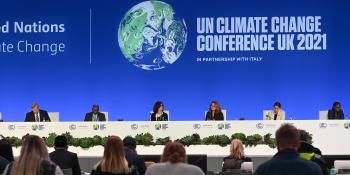Reducing the carbon footprint of dairy in Sub-Saharan Africa

Research suggests that dairy farmers can reduce their carbon footprint by improving animal and herd management.
The growing global population and increasing consumption of meat and dairy will increase global animal protein demand by 60% by 2030. The livestock sector is responsible for about 15% of human-induced greenhouse gas (GHG) emissions. The high carbon footprint (CF) from milk production by smallholders in Africa is predicted to increase significantly in the coming decades; scaling mitigation practices to curb emissions from the dairy sector is vital to reducing emissions and addressing dairy’s role in climate change.
To meet the growing demand for dairy in Kenya and other developing countries while also addressing climate change, it is essential to identify the most effective mitigation practices and then identify the interventions required to catalyze change."
Andreas Wilkes, UNIQUE Forestry and Land Use Gmbh
The CGIAR Research Program on Climate Change, Agriculture and Food Security (CCAFS) helped support and implement a survey and analysis of 382 smallholder dairy farmers in central Kenya. The study describes the first assessment of the CF of milk production in Sub-Saharan Africa based on actual farm management practices of the dairy farms in central Kenya. The study aimed to determine whether there were significant differences in the CF of farms with different feeding systems (i.e. zero-grazing, grazing and mixed systems), and identify factors associated with variability in CF between farms. This analysis identified options for mitigating GHG emissions from Kenya’s growing dairy production.
Download the article: Variation in the carbon footprint of milk production on smallholder dairy farms in central Kenya |
Mitigation options for dairy in Kenya
The study identified various management factors at the individual cow and farm levels associated with the increase or decrease in the CF of milk production in central Kenya. Carbon footprints were found to largely depend on milk yield, feed characteristics, manure management practices, and herd size and composition. In particular, the level of feed concentrate used increased the CF and was the most important factor explaining the variation of the CF not attributable to a difference in milk yield. Customizing feed rations and concentrates according to animal needs throughout the lactation cycle could provide opportunities to increase milk production and reduce the carbon footprint of milk production.
Supporting smallholder farmers to implement these mitigation options will require interventions at several levels in feed supply chains in the dairy sector. Breed improvement is also a mitigation practice relevant in many African countries, and other research has shown that women’s involvement in breeding decisions is associated with higher milk yield. Encouraging and demonstrating the benefits of best practices in feeding and breeding could simultaneously reduce GHG emissions and increase production to meet the growing demand for dairy.
Read more:
- Journal article: Variation in the carbon footprint of milk production on smallholder dairy farms in central Kenya
- Database: CCAFS Big Facts | Food security - Diets
- Guidance document: Livestock Activity Data Guidance (L-ADG)
- Info Note: Further evidence that gender matters for GHG mitigation in the dairy sector
- Info Note: Youth opportunity spaces in low-emission dairy development in Kenya
- Outcome story: Kenya’s State Department of Livestock catalyzes investments of USD 223 million in the dairy sector
Sadie Shelton is the Communications Officer for the CCAFS Flagship on Low Emissions Development.



